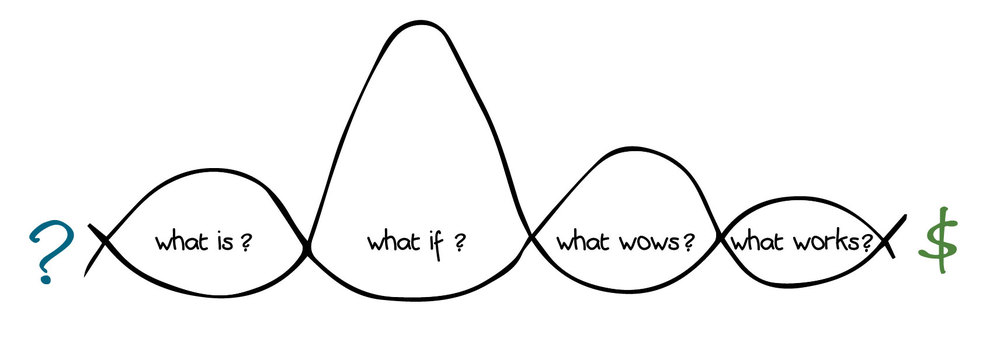Using Design Thinking to Surface Growth Opportunities and Connect with Customers
How do you know if the technologies you are working on today will resonate with customers and support growth in the future?
The short answer is, you don’t. Companies betting on the potential of early-stage markets tackle this question every day from myriad angles – where do you focus, how much do you spend, who should work on the effort, and when do you need to be ready to capture the market? – and still fall short in their understanding. Indeed, due to the complex nature of technology innovation, these questions often remain unanswered for years as the investment in technology programs climbs and the cash hole deepens.
Many tried-and-true tools exist to combat this uncertainty – customer interviews, consumer surveys, secondary research, IP analysis, etc. – but there’s one method that Newry has been exploring recently that we think deserves more attention: namely, design thinking.
When faced with a novel material, design thinkers don’t stop to size the market or analyze profit pools: they go directly to specific product concepts and their potential functions, thereby creating an entirely new lens through which to understand a technology’s true potential for value creation. Through numerous engagements with a variety of design firm partners, we have found that this process and its associated frameworks have the potential to be tremendously impactful for industrial B2B businesses, for a couple of reasons:
1. The power of divergent thinking in finding new revenue
Rather than attempting to drive toward an answer along a linear, logical path, design thinking moves through iterative cycles of divergent and convergent thinking in order to arrive at the best possible solution. This process can feel unfamiliar and even uncomfortable to folks who are accustomed to pipelines and stage gates and screening processes, but we’ve found that it is a highly effective method for finding new applications for clients’ products, even when those technologies have already been around for some time.

The “what is, what if, what wows, what works” framework depicts the iterative cycles of divergent and convergent thinking that designers use. From “Designing for Growth” by Jeanne Liedtka and Tim Ogilvie.
For instance, we partnered recently with a renowned global industrial design firm in an engagement on behalf of a leading specialty materials company looking for creative applications for several of its flagship products. These products had been around for decades in industries ranging from food packaging to sporting goods to building materials, and our client was worried that their potential for growth had been tapped. In an on-site ideation session facilitated by our design firm partner, however, the team surfaced twenty fresh, promising opportunities that were captured in one-page “what if” scenarios. These summaries provided a set of options that, when vetted and analyzed by Newry, amounted altogether to hundreds of millions in addressable near-term revenue – not bad for a set of mature technologies.
2. Using an awareness of consumer needs and preferences to create market pull
One of the major challenges our clients face on a day-to-day basis is their removal from the consumer experience. Although our clients generally do not sell direct to consumers, they sell to customers who do, and meeting those customers’ needs requires a certain level of understanding of the end user – an understanding that can be difficult for our clients to obtain.
We’ve found that design firms can be very effective in bridging that gap and bringing a deep understanding of consumer preferences, customer needs, and industry trends. For instance, we recently engaged with a leading industrial manufacturer attempting to commercialize a new lighting technology. This technology had many unique and potentially interesting characteristics, but our client was struggling to understand which of those would be valued by consumers, so we tapped a design firm with lighting experience to help us understand how our client could capitalize on their technology’s performance attributes to create market pull.

Our design partner facilitated a session that ultimately generated more than 150 new product ideas, exposing our client to new applications and markets that both widened the lens on the functional uses for its technology, and formed the basis for an early selling strategy. To capture value from the markets with the highest potential, our client opted to launch a strategic partnership. Our client’s partner – a company selected to ensure optimal distribution and supply to the markets of interest – recently showcased the new product at a nationally televised championship sports event.
Design firms can be very effective in bringing a deep understanding of consumer preferences and industry trends.
The success of these engagements reflects the unique perspectives of designers who are working across multiple industries and on a range of customer problems. This breadth of experience – in product design, architecture, lighting, UX (interaction design), and ethnography – has helped Newry, and our clients, to see opportunities before a market exists in some cases, enabling an early and “inside” track on potential growth vectors.
In the process, we have learned how designers’ boundary-less creativity and hands-on technical and engineering understanding can bring color, creativity, and clarity to the often cloudy white space of early-stage market exploration.
Find out how Newry can help your organization move smarter to move faster. Get traction in your market.
